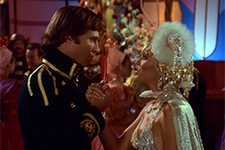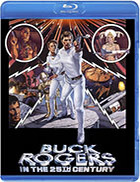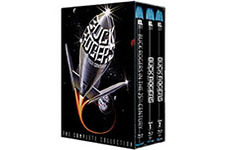Buck Rogers in the 25th Century
|  Buck Rogers in the 25th Century, a television pilot-turned-theatrical feature that spawned two seasons of a TV series, is often understood primarily as a response to Star Wars (1977), George Lucas’s space-opera juggernaut that rewrote the rules of the movie blockbuster and made science fiction a major force in Hollywood. And, to a large extent, this version of Buck Rogers owes its much of its existence to Lucas’s film, as do a host of low-budget sci-fi knockoffs of the era that tried to capture some fraction of Star Wars’s audience-pleasing adventurism. Yet, Buck Rogers in the 25th Century is arguably better understood as a part of a general movement in Hollywood to resurrect in modern form the old movie serials, radio programs, and comic strips of the 1930, ’40s, and ’50s—essentially, the childhood of the filmmakers who then held the keys to the kingdom. The emergent new generation of directors and producers of the late 1970s and early ’80s were intent on reviving the entertainment of their childhood with bigger budgets, more elaborate effects, and a more modern sensibility. Hence, Flash Gordon, which began as a comic strip in 1934, was reimagined via Italian mega-producer Dino DeLaurentiis’s Flash Gordon in 1980; the Lone Ranger, who was introduced in a radio serial in 1933, was resurrected in The Legend of the Lone Ranger (1981); and Tarzan, who began life in Edgard Rice Burroughs’s 1912 pulp novel, was given serious, dramatic treatment in Greystoke: The Legend of Tarzan, Lord of the Apes (1984). And then, of course, there was Steven Spielberg and George Lucas’s Raiders of the Lost Ark (1981), whose globe-trotting archeologist-hero Indiana Jones was born out of their memories of movie serials like Flash Gordon, Don Winslow of the Coast Guard, Blackhawk: Fearless Champion of Freedom, and Commando Cody: Sky Marshal of the Universe. Buck Rogers was no different, having originated in the pulp magazine Amazing Stories in 1928 before being adapted to a comic strip in 1929, radio in 1932, a film serial in 1939, and a 1950–51 television series. The basic plot of the original serialized novel, radio series, and television series are the same: Captain Buck Rogers, a veteran of World War I, is frozen via exposure to radioactive gas in a mine and awakes 500 years later to find the world is a very different place. In the 1979 film version (which was released theatrically, even though it was originally produced as a television pilot), Buck (Gil Gerard) is changed into a NASA pilot in the then-future year of 1987, who flies his Space Shuttle-like ship Ranger 3 through a cloud of space gas that freezes him for five centuries. He is discovered floating in space by the Draconians, whose king wants to conquer the universe and has recently entered into an uneasy alliance with the human race on Earth. A “Great Holocaust” has wiped out everything that Buck would remember from the 20th century, leaving much of the planet a wasteland, although surviving humans have congregated in isolated, advanced cities. Buck is sent back to Earth as a pawn by the Draconians to test the planet’s defense systems, and once there he is treated as a potential spy. He finds himself pulled between the affections of the sultry Draconian princess Ardala (Pamela Hensley), and Colonel Wilma Deering (model-turned-actress Erin Gray), one of Earth’s defense commanders. The film was written and produced by television veterans Glen A. Larson and Leslie Stevens, who brought with them a wealth of experience writing for screens both large and small. Larson, who became best known for creating ’80s prime-time staples like The Fall Guy (1981–86), Magnum P.I. (1980–88), and Knight Rider (1982–86), had previously created Battlestar Galactica (1978–79), some of whose leftover sets were recycled for Buck Rogers, while Stevens was best known as the creator of sci-fi anthology series The Outer Limits (1963–65) and writing and directing the infamous William Shatner-starring feature Incubus (1966), a cult film in which all the characters speak Esperanto. Buck Rogers in the 25th Century is a somewhat odd, unstable mishmash of science fiction and adventure tropes that never really cohere. The tone is all over the place, with blandly handsome former soap opera star Gil Gerard playing Buck in some scenes as a smirking wise-ass and in other scenes as a deadly serious would-be savior. There are obvious attempts at humor, most infamously involving Twiki, a pint-sized humanoid robot with a Golem-like helmet-head, frozen anime eyes, and vacuum-tube arms who wears around his beck a circular artificial intelligence computer known as Dr. Theopolis (Howard F. Flynn). Twiki is voiced by Mel Blanc, the voice artist behind all the Looney Tunes characters, and he mostly makes mechanical “bidi-bidi” sounds unless the writers want him to say something funny, at which point he speaks. The film leaves some gaping plot holes and fail to follow through with certain rules. For example, in one sequence Buck is exploring the wasteland of Earth and is told he cannot spend the night outside because the temperatures will drop well below zero. The sequence then continues well into the night, during which no one appears to be even the slightest bit chilly. Luckily, that is one of the film’s better sequences, as it finds Buck being stalked through urban ruins by a marauding gang of shrouded mutants wielding all manner of blunt instruments. Director Daniel Haller, a veteran of television series like Owen Marshall, Counselor at Law (1972–74), Kojak (1974–76), and Battlestar Galactica (1979), turns it into a mini-horror movie, complete with swirling dry ice, a zombie-like monster hoard, and a creepy cemetery. The film’s visual effects are clearly relics of their era, although it should be noted that they were cutting-edge at the time. Although clearly not in the league with Star Wars, the optical and motion-control effects used to bring the space battles to life hold up decently well, with their primary sin being their lack of depth. The Inner City (aka New Chicago) was an effective combination of highly detailed matte paintings by Syd Dutton (who would go on to an extensive body of work in matte painting and visual effects); the Bonaventura Hotel in downtown Los Angeles; and various buildings from the former Expo 67 site in Montreal, Canada, which had also been used in episodes of Battlestar Galactica and would serve as the main setting for Robert Altman’s odd sci-fi drama Quintet (1979). The interior sets and costumes have an amusingly campy quality to them, as it is clear that the designers did not look much beyond what was considered stylish in the late 1970s to imagine what 25th-century interior design and clothing might look like (a ball sequence is particularly notable in demonstrating how dancing and music in the 25th century are utterly boring and embarrassing). Perhaps to overcome these production deficits, there is a clear desire to infuse as much sexual allure as possible into the film, hence Princess Ardala spending significant portions of her screen time in a silver lamé bikini and the opening credits sequences, which features a genuinely awful ballad by Kipp Lennon over shots of female models lounging their scantily clad bodies on the letters of the film’s title—an obvious and embarrassingly misguided emulation of the opening credits sequences of the James Bond series. Gerard is too bland a presence to explain the competing female affections, but he acquits himself well enough when the action takes over. The pilot was successful enough to spawn two seasons of the television series that ran between September 1979 and April 1981, with the main characters—Buck, Wilma, Dr. Huer (Tim O’Connor), and Twiki—navigating their way through 33 episodes of alien encounters, criminal conspiracies, and intergalactic travel as they attempt to protect the Earth from various take-overs, including repeated attempted by Princess Ardala in the first season. The television series tended to heighten the pilot film’s campier qualities by emphasizing a more light-hearted and comical approach, something that Gil Gerard resented and led to significant tensions between him and the writers and producers. The series was able to draw a number of significant guest stars over its two season, including Jack Palance, Peter Graves, Jamie Lee Curtis, Gary Coleman, Sid Haig, Vera Miles, and, of course, Buster Crabbe, who played Buck in the 1930s film serials, as well as Flash Gordon. Alas, even those familiar faces weren’t enough to keep the series afloat, and it was cancelled after its second season was cut short by a writers’ strike, leaving it without any kind of culminating storyline or proper send-off. In the years since there have been various rumors about a reboot of Buck Rogers, but nothing has materialized, leaving the 1979–81 film and television series as one of the character’s last incarnations.
Copyright © 2020 James Kendrick Thoughts? E-mail James Kendrick All images copyright © Kino Lorber | |||||||||||||||||||||||||||||
Overall Rating: 

 (2.5)
(2.5)


 Buck Rogers in the 25th Century is available as both a stand-alone Blu-ray and as part of the “Buck Rogers: The Complete Collection” box set including both seasons of the television series.
Buck Rogers in the 25th Century is available as both a stand-alone Blu-ray and as part of the “Buck Rogers: The Complete Collection” box set including both seasons of the television series.